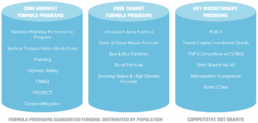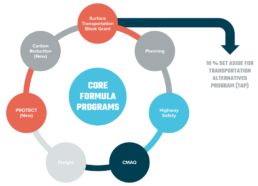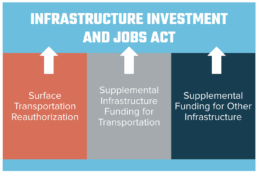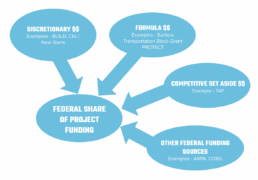US Funding Resource Page
This page serves as an introduction to United States federal transportation funding. It provides guidance for understanding the United States federal transportation landscape and potential funding opportunities to support shared micromobility.
Introduction To US Federal Transportation Funding
Federal Surface Transportation Programs
Since the passage of ISTEA in the early 1990s, federal surface transportation policy is designed to support a range of investments across modes with initiatives broadly divided between highway and transit programs. These investments and resources are provided either through a formula-based distribution or a competitive grant process.

Most funding is provided via formula programs and typically flows to state departments of transportation or regional metropolitan planning organizations (MPOs). These funds have a range of requirements and eligible uses but are designed to be both flexible and predictable. Unlike most federal programs, the formula funding in transportation is not subject to annual congressional appropriations but rather is guaranteed through dedicated gas tax revenues in the highway trust fund (although in recent years general fund revenues have been required to maintain solvency in the trust fund).

The competitive grant programs provide discretion to the U.S. Department of Transportation to evaluate proposals and direct funding based on a combination of statutory and regulatory criteria. These funds are often much more prescriptive than formula programs and, in most cases, subject to annual congressional appropriations.

New Directions in the Infrastructure Investment and Jobs Act (IIJA)
The passage of the Infrastructure Investment and Jobs Act (IIJA) built on this existing structure by maintaining the core formula programs. However, IIJA also made some significant shifts within the overall structure. The IIJA is effective through September 30, 2026. The new law:
- Provides far more funding than has historically been the case through discretionary competitive programs and while subject to specific requirements it is also more focused on multimodal investment
- Sets aside more funds within formula programs for specific uses and flexibility is somewhat reduced
- Gives more opportunities and authorities than previous authorizations to local governments and regional organizations to access and spend funding directly
- Expands both planning and performance measures requirements
- Reflects a new set of policy priorities focused on climate and resiliency, social equity, and maintenance of existing infrastructure. U.S. DOT has also enhanced that focus through initial rules and guidance and incorporated an emphasis on linking transportation to housing and land use
- Creates new initiatives to support the growing electrification of the transportation network.

Shared Micromobility Opportunities
The passage of IIJA creates a range of new opportunities for shared micromobility services and programs. For the first time, the federal CMAQ program provides explicit eligibility for funding shared micromobility. The development of new guidance for the program will be important for determining how this new authority will work in practice. In many other areas, the opportunity for shared micromobility is not explicit, but the continued growth and influence of micromobility can leverage new and reformed programs to open up the potential for funding through collaboration and partnership. In general, the federal transportation program is not a source of operating funds, but broad program eligibilities can allow funding for activities such as planning and design, acquisition of vehicles, station construction, integration with other transportation networks and systems, and technology.
Leveraging Federal Funds for Shared Micromobility
As noted above, while most funding opportunities are provided through the surface transportation reauthorization process– most currently authorized through IIJA, but a past reauthorization bill, for example, was the FAST Act– there are some additional sources of federal funding, all of which can come from transportation discretionary grants, transportation formula funds, competitive set asides, such as TAP, or other funding sources such as ARPA.

Infrastructure Investment and Jobs Act (IIJA) Funding Opportunities
Below, we have provided a spreadsheet that outlines current and future opportunities for federal funding programs in the Infrastructure Investment and Jobs Act (IIJA) that could support the planning, design, and/or implementation of shared micromobility or supportive infrastructure, such as protected bike lane infrastructure. This represents the best of our knowledge so far, and is subject to interpretation and further USDOT guidance, which is evolving particularly as new programs are rolled out.
